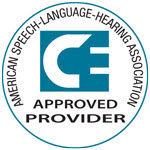
Texas-licensed speech language pathologists have a biennial license renewal with a birth month deadline.
Twenty (20) continuing education hours (30 if dual-licensed) are required for license renewal.
There are no limits on home study if ASHA approved. Two hours of ethics are required at each renewal.
A one-time requirement of the jurisprudence exam is needed and counts for one hour of the ethics requirement.
Click Here to See Continuing Education Courses for Speech Language Pathologists!
Professional Development Resources is approved by the Continuing Education Board of the American Speech-Language-Hearing Association (ASHA Provider #AAUM) to provide continuing education activities in speech-language pathology and audiology. See course page for number of ASHA CEUs, instructional level and content area. ASHA CE provider approval does not imply endorsement of course content, specific products or clincial procedures. CEUs are awarded by the ASHA CE Registry upon receipt of the CEU Participant Form from the ASHA Approved CE Provider. Please note that the completion date that appears on ASHA transcripts is the last day of the quarter, regardless of when the course was completed.
Speech Language Pathologists Continuing Education Courses:
Building Resilience in your Young Client is a 3-hour online course. It has long been observed that there are certain children who experience better outcomes than others who are subjected to similar adversities, and a significant amount of literature has been devoted to the question of why this disparity exists. Research has largely focused on what has been termed “resilience.” Health professionals are treating an increasing number of children who have difficulty coping with 21st century everyday life. Issues that are hard to deal with include excessive pressure to succeed in school, bullying, divorce, or even abuse at home. This course provides a working definition of resilience and descriptions of the characteristics that may be associated with better outcomes for children who confront adversity in their lives. It also identifies particular groups of children – most notably those with developmental challenges and learning disabilities – who are most likely to benefit from resilience training. The bulk of the course – presented in two sections – offers a wide variety of resilience interventions that can be used in therapy, school, and home settings. Course #30-72 | 2014 | 53 pages | 21 posttest questions
Autism: The New Spectrum of Diagnostics, Treatment & Nutrition is a 4-hour online course. The first section of this course traces the history of the diagnostic concept of Autism Spectrum Disorder (ASD), culminating in the revised criteria of the 2013 version of the Diagnostic and Statistical Manual of Mental Disorders, the DSM-5, with specific focus on the shift from five subtypes to a single spectrum diagnosis. It also aims to provide epidemiological prevalence estimates, identify factors that may play a role in causing ASD, and list the components of a core assessment battery. It also includes brief descriptions of some of the major intervention models that have some empirical support. Section two describes common GI problems and feeding difficulties in autism, exploring the empirical data and/or lack thereof regarding any links between GI disorders and autism. Sections on feeding difficulties offer interventions and behavior change techniques. A final section on nutritional considerations discusses evaluation of nutritional status, supplementation, and dietary modifications with an objective look at the science and theory behind a variety of nutrition interventions. Other theoretical interventions are also reviewed. Course #40-38 | 2013 | 50 pages | 30 posttest questions
Animal Assisted Therapy is a 2-hour online course. In Animal-Assisted Therapy (AAT) the human-animal bond is utilized to help meet therapeutic goals and reach individuals who are otherwise difficult to engage in verbal therapies. AAT is considered an emerging therapy at this time, and more research is needed to determine the effects and confirm the benefits. Nevertheless, there is a growing body of research and case studies that illustrate the considerable therapeutic potential of using animals in therapy. AAT has been associated with improving outcomes in four areas: autism-spectrum symptoms, medical difficulties, behavioral problems, and emotional well-being. This course is designed to provide therapists, educators, and caregivers with the information and techniques needed to begin using the human-animal bond successfully to meet individual therapeutic goals. Course #20-62 | 2012 | 30 pages | 20 posttest questions
Data gathered from the Texas Board of Examiners for SLP/A on September 29, 2014.
Like this:
Like Loading...











